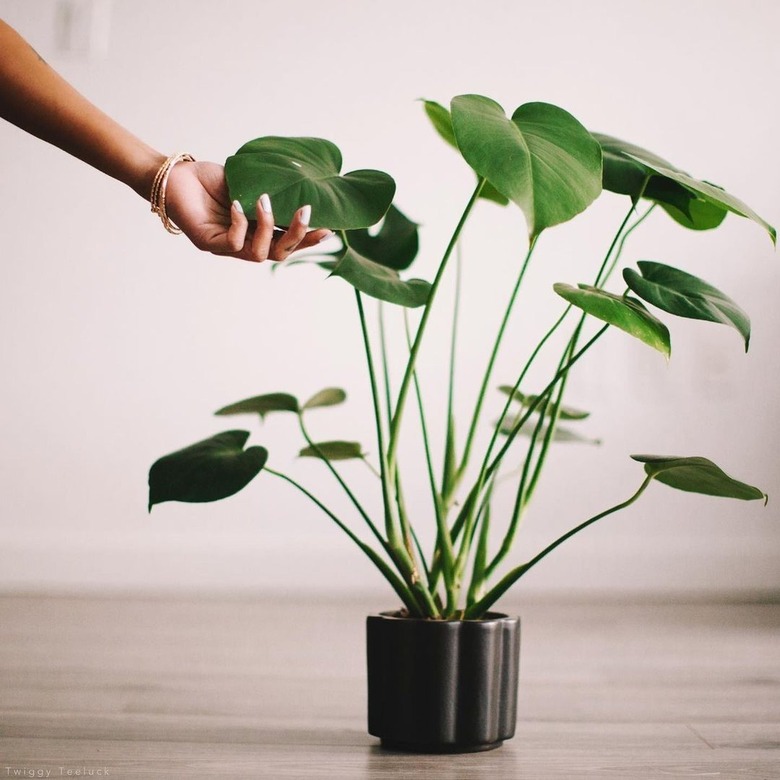How To Get Rid Of Gross Bugs In Plants, According To An Expert
We may receive a commission on purchases made from links.
Bugs in plants are never a welcome appearance. But, like most pests, that doesn't stop them from popping in unannounced. To help us all combat the dreaded spotting of movement in soil, we spoke to Erin Marino, Director of Brand Marketing at The Sill, who shared her expert tips and advice for ridding your greens of any and all bugs. "Common plant pests include mealybugs, scale, spider mites, fungus gnats, thrips, and slugs," she explains. "These pests might sound creepy crawly but it's important to remember these bugs are only interested in your plants! Not you, your pets, or your furniture." (Cue sigh of relief.) She also wants to reiterate that bugs are normal — plants are living things after all!
Marino tells us the first step to eradication is to identify which type of crawler calls your plant home and treat from there — here are her expert tips, no matter which type of bug you're seeing.
1. Mealybugs
1. Mealybugs
If you notice an oval-shaped insect covered by waxy, white cotton-like filaments within your plant, it is most likely a mealybug. They can be found in different parts of the plant but are commonly found on stem nodes, leaf axles, and along the veins on the underside of the leaves, and you may also find them in the root system of the plants. Spot-treat visible bugs with a cotton swab or cotton pad dipped in alcohol, then spray all of the foliage down with a neem oil solution or insecticidal soap. Examine your plants weekly for traces of re-infestation.
2. Scale
2. Scale
Scale is another oval-shaped pest that is enclosed in a shell-like covering if it has matured enough. They are typically brown in color but can also be black or white. Mostly found along leaf veins or on stems, a mature scale will need to be picked off of your plant manually because insecticidal treatments will not penetrate through the bug's shell. After you remove all scale, the plant can then be sprayed down with a neem oil solution or insecticidal soap.
3. Spider Mites
3. Spider Mites
Spider mites are microscopic insects that are usually red or yellow in color. However, you can easily identify them by the silky webbing they leave behind and grayish stippling on the foliage. They usually congregate on new growth on plants and the underside of leaves. Boosting humidity in your home can help ward off a spider mite attack because these pests thrive in hot, dry air. Use an insecticide that lists "spider mites" on the label to target pests and spray down the plant. Treat your plant after three days, and again in 10 days.
4. Fungus Gnats
4. Fungus Gnats
If small bugs are flying around your plant, they're probably fungus gnats. Fungus gnats are 1/8 inch grayish, adult flies with delicate wings and long legs. They are often found around the growing season, during favorable conditions, flying around the soil. Fungus gnat's larvae, however, feed on organic matter within the soil. We recommend starting to remove these pests by setting up yellow sticky-traps, which can help capture the flying, adult gnats. Incorporating diatomaceous earth or mosquito bits in the soil and repotting your plant in fresh soil can help eradicate larvae. Fungus gnats also love moisture, so let your potting soil dry out completely between waterings.
5. Thrips
5. Thrips
If you notice elongated insects varying in length from one to two millimeters with a brown or black body and bristle-like wings, you likely have thrips in your plants. Younger stages of thrips will appear more light in color to green. These pests have piercing mouthparts that feed off of cell guts and the injured plant tissue will have a silvery, stippling appearance. It looks like the chlorophyll is getting scraped off of the plant. New plant growth can come up distorted and brown; dying tissue may also occur in the areas. Heavily infested plants will have little black dots, which is the pests' fecal matter. We recommend keeping thrips-infested plants isolated in a separate area to avoid spread. You can use an insecticide spray to fight off this pest.
6. Slugs
6. Slugs
You might think of slugs as an outdoor pest, but they can affect houseplants, too. Slugs are nocturnal feeders that can vary in color from gray to brown, leaving slimy trails behind. While these are not as common as other houseplant pests, they may appear from time to time, if ragged holes are developing on leaves. They hide under planters and in the soil during the day and can be found directly on the foliage at night when they come out of hiding. You can try leaching the soil if they are dwelling there at night. Otherwise, we recommend looking into slug pellets and traps if an infestation arises.
